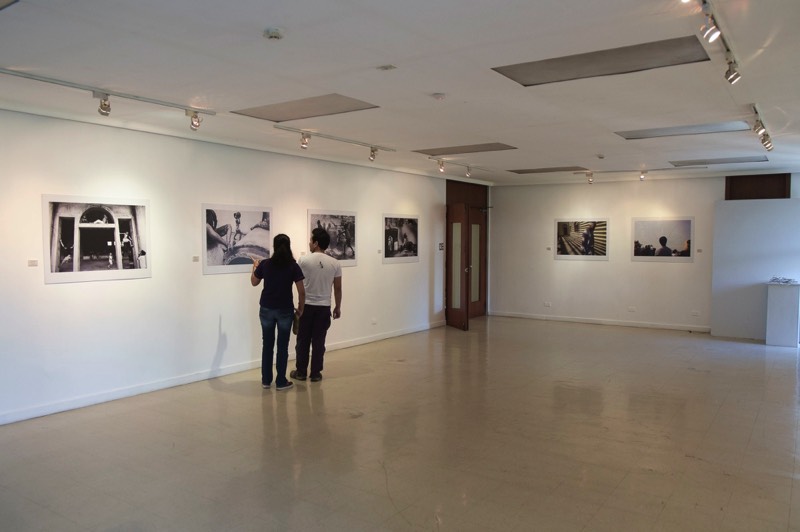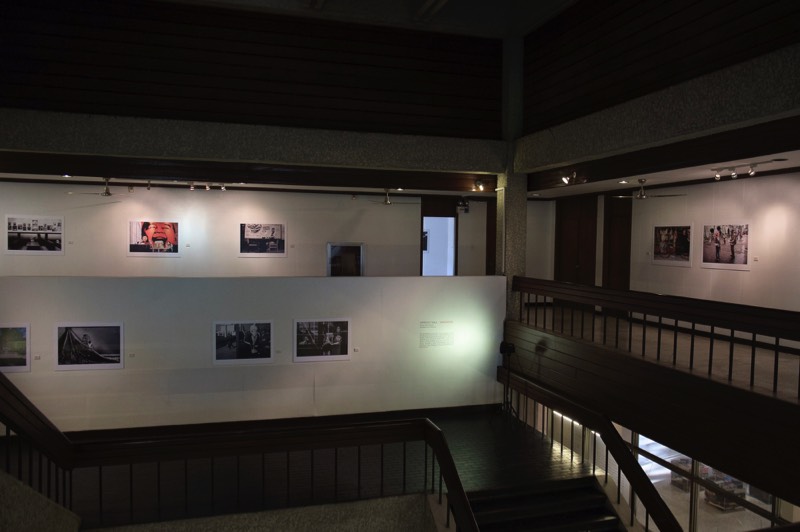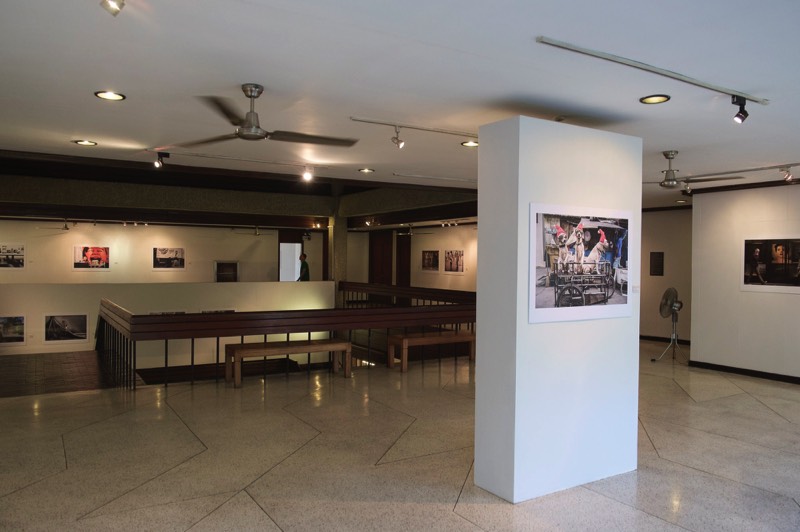reFrame-reFocus
all about photographs

Review of Unscripted… Unpredictable…
Street photography Exhibition at Vargas Museum University of the Philippines
Ateneo Sta. Ines, Jayvee Mataro, Joel Mataro, Rommel Bundalian, Little Wing Luna, Kimpoy del Prado, Ed de Guzman, Gian James Maagad, Xyza Cruz Bacani, Elpidio “Loi Lee” Juan, Jojo Pensica, Leonard G. Reyes, David Mar Quinto, Jomel Bartolome, Ben Molina, Rick Rocamora and Arthur Quejadas II.
At the dawn of photography in 1839 there were two types, the studio photograph and the street photograph. Both Fox-Talbot and the first practitioners of the Daguerreotype made photos on the streets. Since that point it has been one of the key genres of photography. Perhaps the genre’s height was with the introduction of the Leica cameras in the 1930s where people did not realise that images were being made. This gives the work of Henri Cartier Bresson and his contemporaries a feeling of the camera being invisible, which to the people in the photographs at that time, it was. Interestingly that situation has presented itself once again, with phone cameras allowing the ability to make images of which the subject is completely unaware. Lucien Samaha in NYC was one of the first to see the potential of using the phone to create a new type of candid photography. Now we live in a world which cameras are everywhere observing everything, both in the hands of photographers, members of the public with cameras, people with phones, government agencies, businesses.
Into this moment, with all the accumulated history of 175 years of photography, on the streets comes Unscripted… Unpredictable… an exhibition curated by Rick Rocamora which brings together 17 street photographers from various backgrounds and countries of residence into this exhibition of 40 prints at the Art Museum of the University of the Philippines.
These images have two things in common. They were made by street photographers, determined by their own definition or by the works they make. Secondly they are all born in the Philippines and lived their formative years there. This guides the viewer to ask the obvious question, is there a uniquely Philippine way of seeing the streets? Are the cultural themes and tropes incorporated in either the selection of the work or intrinsic to the work? If so, looking at the work from the diverse places do these themes jump out at us?

As anyone who has organised an exhibition knows, a lot of work goes into any venture like this, and when you are not in a paying curatorial position, it is necessarily a passion project. Rick Rocamora now in his 60s, says that he has been proactive in finding and giving back to Filipino street photographers. He has offered advice and assistance to the talent that he has spotted in various forums on Facebook, Flickr other medai. He is always on the lookout for talent.
Although this exhibition is only an introduction to the street photography of Filipinos, the work of each of these photographers is strong enough to warrant more attention. Attention has already come to a number of the participants, in the form of publications and awards. There appears to be a kindness and passion in this project, even a camaraderie, if that is not a dirty word now.
The elements of humour and irony, which have always been part of street photography are well represented here. Although in 6 out of 40 prints, the replacement of becomes a bit repetitive. Loi Lee Juan’s Yoshinoya image is so well captured that it takes more then a moment to work out what goes with what. The quality of photography the curator had to play with should have allowed the exhibition to be a little more expansive and incorporate some more of the edgier compositions and subject. The visual interactions of the advertising posters with the people is also well represented. Another street photography trope of reflection in glass is also on display, the use of humour though umbrellas, less well known.
Street photography is the genre of photography that takes the greatest liberties with framing. Yet this show owes more to Werner Bischof’s work than to Robert Frank or Bruce Gilden. Most of the selections are very clean, and isolate the action. Ateneo Sta. Ines’ Basketball Players is a great example of playing with the framing to gain a more dynamic (even chaotic) composition. Looking at Arthur Quejadas II’s Flickr feed and comparing it to his represented prints here, I was disappointed, given his flickr images are very frenetic, with compositions more in keeping with the nature of the street.
I’m not sure why, but I found the work made in the Philippines more compelling then work made elsewhere. The work made in Hong Kong for example is very strong, yet, being black and white, in my head it was being compared to Fan Ho’s work, and he is probably the best street photographer that ever worked in that city. Having said that, the Xyza Cruz Bacani image of the man lying with a towel on his face is the strongest in the exhibition. The Korean images seem sterile, but that city out in the suburbs is very much like that, in this Arthur Quejadas II has captured it honestly.
The work in the Philippines seems to have a solidness about it, and serendipity that is lacking in the other places, perhaps there is nowhere like home? Romel Bandalian’s image of the late afternoon sun is particularly evocative of walking around Asian cities. Campy del Prado’s shadow is perhaps the most compelling image in the show. It has exquisite balance between the large graphic elements of shadow, blue wall and red door and so much texture. The detailed shadow of the girl walking and texting down stairs has all the mystery and anticipation of a Giorgio de Chirico work.
The word that comes through the artists’ statements and looking at the work is ‘curious’. I’m not sure that curiosity, humour, serendipity or camaraderie are particularly Philippine traits. If this exhibition is looking for a ‘Philippine way of seeing’ I feel it doesn’t achieve that. If the exhibition was looking for a group of photographers who were looking to the streets to find today’s beat, then it is successful. The work does not feel totally new, but it is solid. It is as great as work coming from any other place and perhaps that is the key to street photography. At this point in photography’s history, perhaps street photography is like English Rock, it is not going to be radically new, but each new generation needs to find their voice within the codified style and make it their own. Like rock, it will become nostalgic, a time capsule, for us all to look back on and remember our past.
Garrie Maguire
Although this exhibition is only an introduction to the street photography of Filipinos, the work of each of these photographers is strong enough to warrant more attention. Attention has already come to a number of the participants, in the form of publications and awards. There appears to be a kindness and passion in this project, even a camaraderie, if that is not a dirty word now.
The elements of humour and irony, which have always been part of street photography are well represented here. Although in 6 out of 40 prints, the replacement of becomes a bit repetitive. Loi Lee Juan’s Yoshinoya image is so well captured that it takes more then a moment to work out what goes with what. The quality of photography the curator had to play with should have allowed the exhibition to be a little more expansive and incorporate some more of the edgier compositions and subject. The visual interactions of the advertising posters with the people is also well represented. Another street photography trope of reflection in glass is also on display, the use of humour though umbrellas, less well known.
Street photography is the genre of photography that takes the greatest liberties with framing. Yet this show owes more to Werner Bischof’s work than to Robert Frank or Bruce Gilden. Most of the selections are very clean, and isolate the action. Ateneo Sta. Ines’ Basketball Players is a great example of playing with the framing to gain a more dynamic (even chaotic) composition. Looking at Arthur Quejadas II’s Flickr feed and comparing it to his represented prints here, I was disappointed, given his flickr images are very frenetic, with compositions more in keeping with the nature of the street.
I’m not sure why, but I found the work made in the Philippines more compelling then work made elsewhere. The work made in Hong Kong for example is very strong, yet, being black and white, in my head it was being compared to Fan Ho’s work, and he is probably the best street photographer that ever worked in that city. Having said that, the Xyza Cruz Bacani image of the man lying with a towel on his face is the strongest in the exhibition. The Korean images seem sterile, but that city out in the suburbs is very much like that, in this Arthur Quejadas II has captured it honestly.
The work in the Philippines seems to have a solidness about it, and serendipity that is lacking in the other places, perhaps there is nowhere like home? Romel Bandalian’s image of the late afternoon sun is particularly evocative of walking around Asian cities. Campy del Prado’s shadow is perhaps the most compelling image in the show. It has exquisite balance between the large graphic elements of shadow, blue wall and red door and so much texture. The detailed shadow of the girl walking and texting down stairs has all the mystery and anticipation of a Giorgio de Chirico work.
The word that comes through the artists’ statements and looking at the work is ‘curious’. I’m not sure that curiosity, humour, serendipity or camaraderie are particularly Philippine traits. If this exhibition is looking for a ‘Philippine way of seeing’ I feel it doesn’t achieve that. If the exhibition was looking for a group of photographers who were looking to the streets to find today’s beat, then it is successful. The work does not feel totally new, but it is solid. It is as great as work coming from any other place and perhaps that is the key to street photography. At this point in photography’s history, perhaps street photography is like English Rock, it is not going to be radically new, but each new generation needs to find their voice within the codified style and make it their own. Like rock, it will become nostalgic, a time capsule, for us all to look back on and remember our past.
Garrie Maguire

